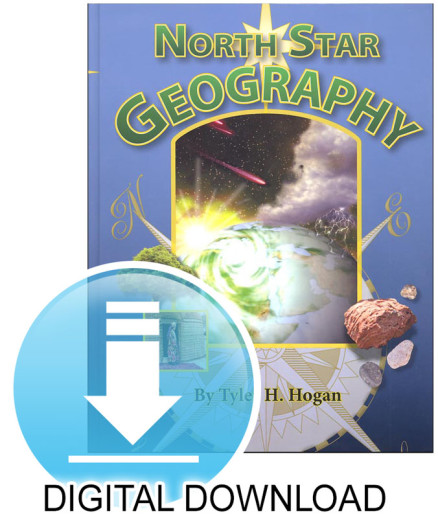We use cookies to make your experience better. To comply with the new e-Privacy directive, we need to ask for your consent to set the cookies. Learn more.
North Star Geography Student Reader and Companion Guide Digital Download
e-book (not print version). Product is entirely digital.
Have you ever stopped to realize that a comprehensive understanding of the earth, its structure, and its inhabitants are a necessary foundation for interacting meaningfully with our increasingly global-minded world? Taking an overview approach, the North Star Geography course covers geography skills (reading maps, using geographic tools, cartography, surveying, and navigation), physical geography (geology, meteorology, oceanography, ecology, hydrology, and astronomy), and human geography (sociology, culture, religion, transportation, agriculture, government, and economics). Bright Ideas Press and world geography, what a great idea! The student reader plus companion guide downloadable PDF file include activities, maps, hands-on projects, research options, and quizzes/tests. Features quality content, a Biblical worldview, and user-friendliness all rolled up into one package!
The text or Student Reader is the heart of the course. Each of the sixteen lessons provides 15-20 pages of reading text, full-color illustrations, photos, sidebar articles, and maps. Lessons are divided into teaching segments which are both highly readable and interesting. The organization lends itself to flexibility, and the course could be done over one year (two weeks per lesson), two years (four weeks per lesson), or even one semester (one week per lesson – a bare bones approach). Vocabulary words are in bold, with definitions provided in the glossary at the end of the text. The Reader concludes with a reference list that provides options for further study.
The accompanying companion guide PDF file is now downloadable (download instructions provided inside the book). It provides both basic and "extra" activities in addition to all content from the Reader. It's these PDF files that will allow you to tailor the course for high school, for junior high, or for a combination of ages. Families may make photocopies or print pages as needed, but classrooms and co-ops should contact the publisher for a multiple-use license. Depending on the course time-frame you choose, you will probably have to assign only some selection of activities, as there is a wealth provided.
- Hands-On Activities are varied and plentiful. Some are short and simple, some more involved. Materials lists are provided when necessary (and tend to be easy-to-get items).
- Build Your Own Atlas: there's a segment for each lesson that includes labeling outline maps, completing fact files, and creating a set of political, physical, and thematic maps. Outline maps are provided, but a good atlas as a reference is helpful (i.e. Wondermaps or Atlas of World Geography).
- Note-Taking Pages: each lesson has a set of 10 questions taken from the text that serve as lesson review and a study guide for the quizzes.
- Memorization Lists include a list of 198 countries, 70 regions and physical features to learn roughly 16 items per lesson.
- Research Questions include a set of questions for each continent which encourage the student to conduct his own research (answers included).
- Quizzes and Tests quizzes for each lesson (based on note-taking questions and map work). A final exam includes questions taken from all 16 of the lessons (answer keys and grading rubrics included).
- Graphic Organizers – these can be used for all types of studies world/continent, country, culture, regional geography, and government fact files.
Homeschool geography courses have tended to be research frameworks that can be used by multi-age students, often over several years. While having lots of advantages for families they require planning, preparation, and often outside resources. North Star takes a different approach, providing a very solid base of textual information but giving lots of options for additional activities and research. It provides all necessary forms and pages, requiring only a good world atlas to accompany the course. ~ Janice
| Product Format: | Other |
|---|---|
| Brand: | Bright Ideas Press |
| Grades: | 7-12 |

